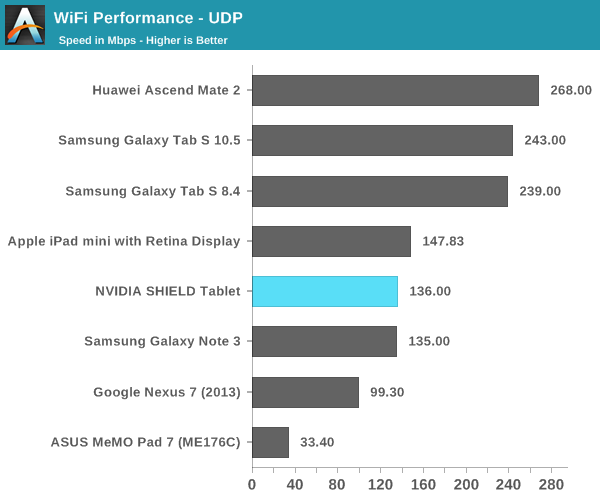The NVIDIA SHIELD Tablet Review
by Joshua Ho on July 29, 2014 9:00 AM ESTWiFi Performance
For the most part these days it seems that the situation for WiFi is much better in mobile than it is anywhere else, but it's still important to test throughput, especially on a device like the Shield tablet that requires low latency, high bandwidth connections in order to support GameStream and GRID. To this end, while NVIDIA hasn't shipped 802.11ac the Shield tablet ships with a 2x2 antenna configuration for a maximum PHY rate of 300 Mbps. Like the Shield portable, this is a BCM43241 chip, likely shared to improve economies of scale. To look at how it performs, we turn to iperf. Before we get into the results of the test, I'd like to thank ASUS for providing the RT-AC68U router to test WiFi perfomance.

Surprisingly, the Shield tablet performs about as well as some single stream 802.11ac solutions like the one found in the Galaxy Note 3. Performance is generally in line with what we'd expect for such a solution, although it would be nice to see 802.11ac for future products.
Camera
While I currently don't have the means to properly test camera, there are still some things to talk about for camera. Both the front and rear camera modules use OmniVision's OVT5963 sensor, which appears to be a 1/4", 5MP sensor. The rear camera has an F/2.0 aperture with 2.95mm focal length, and the front camera has an F/2.8 aperture, with a claimed 4.76mm focal length, although the field of view appears to be somewhat wider. This is the same sensor as the camera in the Nexus 7 (2013). As a rear facing camera, the quality is nothing special but as a front facing camera it's surprisingly high quality. The photo above is with the rear facing camera, the photo below is from the front facing camera. The stock camera application also doesn't show the correct aspect ratio for the camera, so the preview is cropped.
Audio
While I don't have the equipment available to test audio quality and peak volume quite yet, subjectively the two bass reflex ports and dual front facing speakers make for a great experience. It's definitely a major advantage over other devices when it comes to watching movies and playing games as I don't have to cup my hand around the speaker. The larger size of the tablet formfactor means that the stereo separation is much more obvious. On the headphone jack, the device appears to be using a Realtek RT5639 codec. It seems that NVIDIA has continued to use their own speaker protection system that runs on the SoC, as there isn't any clear evidence of a speaker protection IC connected via I2C.












174 Comments
View All Comments
surbringer - Tuesday, July 29, 2014 - link
Have you tried to run PPSSPP on it ?kyuu - Wednesday, July 30, 2014 - link
I can run PPSSPP on my Venue 8 Pro, and the K1 in this tablet is certainly much more powerful GPU-wise than Bay Trail. Shouldn't be an issue.Johnny_k - Tuesday, July 29, 2014 - link
Correction: you now can use Gamestream outside your house, (even over lte on the lte tablet version)Remotely access your PC to play your games away from your home.
http://shield.nvidia.com/play-pc-games/
Note that it is in beta
RoninX - Tuesday, July 29, 2014 - link
I'd love to see Anandtech do a real-world test on how well Gamestream works with the Shield outside the home.chizow - Tuesday, July 29, 2014 - link
Yes, unfortunate AT did not cover this at all, as I also recently found out GameStream remote was in beta. This is really the killer-app for Shield until Android gaming takes off (if it ever does). I would consider buying one of these if Remote GameStream worked decently well, but I'll probably hold off on either a Shield Portable 2 (with TK1) or a good GeForce bundle with Maxwell.ams23 - Tuesday, July 29, 2014 - link
I am impressed that Shield tablet has even higher graphics performance in GFXBench 3.0 T-Rex HD Offscreen than the actively cooled Surface Pro 2 and Surface Pro 3: http://images.anandtech.com/graphs/graph8296/65868...Note that thermal throttling behavior on Shield tablet is extremely good. There was virtually no throttling until after 115 runs (!) with the GFXBench 3.0 T-Rex HD benchmark: http://images.anandtech.com/doci/8296/TRexRunDownG...
I suspect that the 3dmark Unlimited scores are CPU-limited to some extent. Shield tablet already achieves > 200 fps on game test 1 and > 100 fps on game test 2, so this particular test is not very stressful (relatively speaking) for this GPU.
The web browsing battery life is pretty good all things considered, especially compared to iPad Mini Retina and iPad Air (which have 23% and 64% more battery capacity, respectively than Shield tablet). The Shield tablet has CPU and browser performance that is at least 2x faster than Nexus 7 2013 variant, so the web browsing efficiency is actually quite good in comparison.
UpSpin - Wednesday, July 30, 2014 - link
agreed, those results are impressive and a huge step forward, for both NVidia and all the others.Considering that the Shield uses the ancient quad core 32-bit Cortex A15 variant of the Tegra K1 and NVidia also has a custom dual core 64-bit variant of the K1 I think we can expect a further CPU boost once this 64-bit SoC reaches customers.
jospoortvliet - Thursday, July 31, 2014 - link
The A15r3 is not exactly ancient but I agree that Denver is something to look forward to 😎Anonymous Blowhard - Tuesday, July 29, 2014 - link
>Games like Saints Row 3 played as if running on a consoleSo, 720p30, Low Detail? ;)
Death666Angel - Tuesday, July 29, 2014 - link
Zing! :D